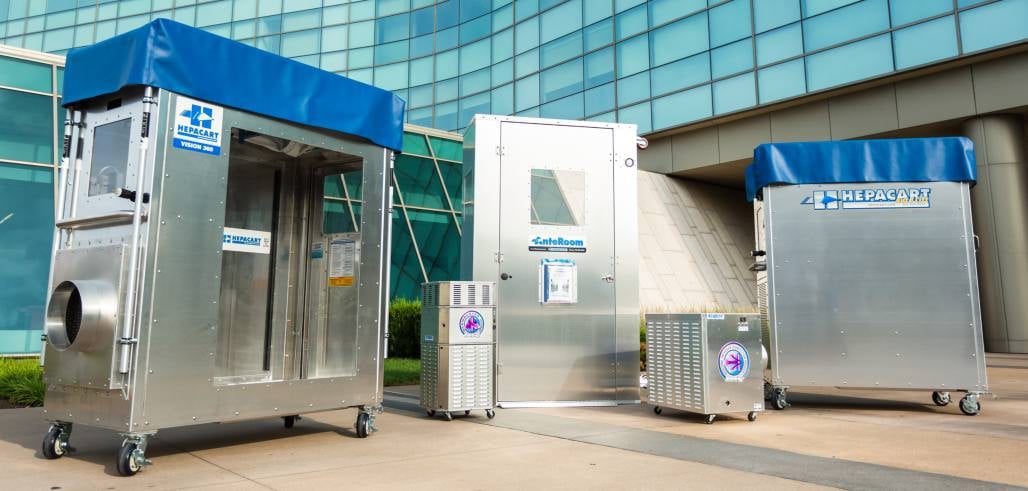
Everything you need to know about dust containment units including what they are, the dust containment problems they provide solutions for, and other considerations of purchase and use.

A dust containment unit is a piece of equipment that encloses and isolates a work space, usually within a high-risk environment such as hospitals, other healthcare facilities, and data storage centers. They prevent dust and other hazardous particles from contaminating the surrounding environment.
But while dust containment units are powerful tools in the dust containment arsenal of healthcare facility managers, construction companies, and managers of sensitive electronic equipment, they’re not the only solution. So what is the big deal about dust containment units, and how do they fit into the goals and processes of dust containment?

No one wants to be in an environment where the air is dusty and surfaces are dirty, but dust containment takes cleanliness to the next level. Dust containment refers to the regulations, methods, processes, and tools required to maintain clean environments that are free of particles that compromise air quality.
For more information on dust containment regulations, see our blog here. To learn more about the methods, processes, and tools involved in dust containment, read on.
While mass market technologies like home vacuums with HEPA filters are on the rise, dust containment practices are most often used in high-risk environments due to their rigorous standards for air purity. The following are two of the most common applications of dust containment solutions:
Necessary in any healthcare setting, dust containment is essential to maintaining the cleanliness of patient care spaces and preventing infection during periods of time where a patient may have a weakened or suppressed immune system. Dust containment for patient protection is an important consideration for hospitals, outpatient care facilities, and long-term care facilities such as nursing homes. This is especially true in cases where such facilities are undergoing construction, renovation, or maintenance that involves ceiling access, sanding, and other activities which may release dust into the environment.
To learn more about the role of dust containment in infection control, see our Practical Guide to Infection Control for Healthcare Facilities.
Electronics are notoriously susceptible to dust, and considering the volume and sensitivity of data stored in the cloud by individuals and businesses alike, it’s no small wonder that dust containment would be employed to protect sensitive processor heat sinks in clean server room environments. Dust containment tools for data storage protection can be permanent fixtures, such as anterooms which maintain air purity by preventing particles from outside the room from entering, or temporary solutions to dust containment in cases of maintenance that requires ceiling access.
There are many situations in which dust control is necessary, and not all of them require the level of thoroughness and precision that characterizes dust containment. But while the overarching goal for both of the dust control practices is maintaining a safe working environment, the methods and measures of success have significant differences.
The first difference between dust containment and dust abatement, and the one that defines all other differences, is the environments and situations in which each dust control practice is used. Unlike dust containment, dust abatement is most often employed on large scales, and in environments that are difficult to control, such as:
In these situations, complete removal of dust from the air is an impossible goal. Instead, the aim of dust abatement is to maintain environments that are safe for working or habitation, reduce environmental impact, and prevent loss of visibility. Several methods can be employed, depending upon the circumstance, the most common being:
Water. Widely used due to its effectiveness and cost efficiency, spraying down construction sites and other high-dust environments adheres particles to the ground, preventing air contamination.
Vegetation. In large-scale construction and natural environment control, planting hardy vegetation prevents the wind from lifting dirt into the air.
Barriers. Creating wind fences can prevent the spread of dust in dry environments and active construction sites.
Polymers. In areas that do not receive vehicle traffic, polymers help to bind soil particles together, creating a barrier on the surface of the ground. (Source)

So how does dust containment work? While each situation may require a slightly different approach, there are several solutions that can be used in conjunction to comply with regulations and maintain safe environments.
One tool option for dust containment is a dust containment unit, which broadly refers to standalone enclosures, both mobile and stationary, that isolate small areas from their surrounding environments. Usually constructed from aluminum or other medical grade materials, these units can be sterilized and reused for multiple projects and situations. Dust containment units can also come equipped with negative air machines, HEPA and ULPA filtration systems, and additional features that combine dust containment solutions for the convenience of workers.
Dust containment can also be achieved with temporary barriers and enclosures, which can be achieved through both disposable and reusable tools. Disposable dust containment barriers, such as polyethylene plastic sheeting, pole systems, and other similar methods, are a common solution to situations in which dust control is required infrequently, such as small-scale construction or renovation. However, disposable barriers may be expensive for high-risk environments and applications where dust containment regulations mandate frequent containment measures. In these cases, reusable barriers such as temporary walls can make containing dust to larger areas more cost-effective.
Temporary barriers are best suited to projects or situations in which a large area needs to be isolated from its environment, or when the shape of the working area is irregular and the enclosure must be customized.
High-risk environments such as healthcare facilities are no strangers to the concept of proper air ventilation. For example, in hospitals, guidelines for air supply rate have been set by ASHE at 30 to 40 air changes per hour, and infection control guidelines define air pressure for patient care spaces. In any environment where dust containment is required, both permanent ventilation systems and temporary ventilation measures can be used as containment measures.
In permanent ventilation systems, properly maintained HEPA filters ensure that particles from an isolated area are captured before moving the air to other areas of the building. In the case of data storage or other sensitive electronics stored in a clean environment, installing HEPA filters in the ventilation helps to preserve the air quality within the room.
For construction, maintenance, and renovation projects in sensitive environments, temporary ventilation measures such as negative air machines create negative air pressure as compared to the surrounding area, preventing particles in the air from moving outside of the enclosed environment. This contaminated air can then be vented outside, or another location that won’t endanger anyone.
Of course, no matter how well isolated the work space is from its surrounding environment, workers within the environment need additional protection to ensure their safety. Depending on the work being done, any of the following may be necessary to maintain worker safety as well as reduce risk of contamination outside of the work space:
Respirator masks
Safety goggles
Coveralls
Shoe covers
Gloves
Precautions should be taken to remove PPE in a safe environment before leaving a work space, and protocols for cleaning or disposing of contaminated equipment should exist.
Though dust containment does not happen on the same scale as dust abatement, as mentioned above, some of the same dust control methods are applicable in any situation where dust containment is required. For example, in construction or maintenance situations, wet drilling and wet sanding where possible will reduce the amount of particles released into the air. Frequent cleaning and standardized disposal practices should also be part of dust containment protocol.

Dust containment units are versatile and powerful tools, and with several options and variations available, some are better suited than others to specific applications. But when you’re considering a dust containment unit for your facility or business, what are the factors you need to consider in order to make the best decision?
As the name implies, mobile dust containment units are easy to move and position for the isolation of small work areas. The most common type of mobile dust containment unit is the ceiling access cart, which is usually large enough for one to two workers to access ceiling tiles, ducting, and wiring in high-risk environments.
This type of unit is frequently utilized in high-risk environments in which maintenance involving ceiling access occurs frequently, where dust created from construction and maintenance has significant consequences, or both. In addition, construction companies who work in healthcare spaces or around sensitive electronic equipment may have their own mobile dust containment unit to ensure the cleanliness of the surrounding areas.
Stationary dust containment units are designed for longer-term dust containment than mobile units, though some can also be used for short-term projects and applications. Anteroom enclosures, for example, can be used to isolate entire rooms, hallways, and wings for renovation, maintenance, or infection control purposes.
There are several features to be aware of when choosing the right dust containment unit for the job.
Integrated Negative Air Machine & Filtration. Does the unit have a stock or optional embedded negative air machine? An included air pressure and filtration system adds additional protection both within the isolated area and for the surrounding environment.
Security Features. When construction or maintenance needs to take place in an active work environment, door locks and windows for visibility make it easy for workers to secure the work area.
Worker Safety. Dust containment units should keep not only the surrounding environment safe, but also the workers using them. Safety features may include everything from structural stability to proper lighting.
When you look at the cost of a dust containment unit as compared to disposable solutions, it can be difficult to get past the price tag. Like all machinery purchases, or indeed any business investment, it’s important to look at not only the cost, but also the return on investment and total cost of ownership of a new dust containment unit.
Return on investment (ROI) refers to how much you save (or lose, in the case of negative ROI) due to your purchase. Its basic calculation is Gain on Investment minus Cost, divided by Cost. Some things to factor into your ROI calculation are:
The money saved on not needing to buy disposable barrier material
The business gained from increased efficiency and trust
The time saved in putting up and taking down temporary barriers
Total cost of ownership (TCO) refers to the sum of all direct and indirect costs incurred due to a product or system. Generally, the lower the TCO as compared to an existing solution, the more viable the investment. Some factors in the TCO of a dust containment unit are:
Initial cost
Replacement filters
Upkeep
Sanitization
Transportation costs
Upgrade options
The TCO compared to the lifecycle of the unit will help you weigh the viability of the solution for your applications.
Though it may seem superficial in the face of the time, money, and even life-saving potential of a dust containment unit, a unit’s appearance can play a large role in how safe a work environment seems to outside observers. Disposable or dirty enclosures in a patient care space, for instance, may reflect poorly on the workers or the facility itself, and cause observers to lose trust in the quality of work and care provided.
For construction and maintenance companies, a professional-looking dust containment unit can also help foster trust with clients. By showing that you take dust containment seriously, your reputation as a trusted and professional team will grow.
Finally, a dust containment unit may have the basic functions to get the job done, but what extra features can it provide to ensure the job gets done quickly and well? Depending on your needs, look for a unit that has:
Compartment for walk-off mats
Enough space for one or two workers to maneuver
Adequate lighting
Power outlets for tools
Ceiling, upper wall, and lower wall access
Sealing mechanism for doors and ceilings
Purchasing and using a dust containment unit during construction and everyday maintenance helps to ensure safety in high-risk environments, but without understanding all of the options available, it's impossible to know if you're getting the best value for your needs. By taking all of these factors into account, you'll be better equipped to choose a dust containment unit that fits seamlessly into your operations.
In environments where dust containment is a top priority, few tools offer better outcomes than a high-quality dust containment unit. HEPACART® dust containment products are used around the globe to ensure safe work spaces in hospitals, long-term care facilities, data storage centers, and more. To learn more about our dust containment solutions, check out our free resource, comparing the units we produce and sell.
Unit 3
Guardian Point
Guardian St
Warrington
WA5 1SJ